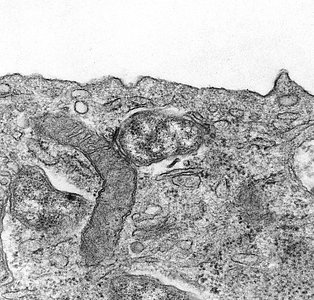alpha Proteobacteria
- Rhodospirillales
- Rickettsiales
- Rhodobacterales
- Sphingomonadales
- Caulobacterales
- Rhizobiales
- Parvularcula bermudensis
- Kordiimonas gwangyangensis
References
Cho, J.-C. and S. J. Giovannoni. 2003. Parvularcula bermudensis gen. nov., sp. nov., a marine bacterium that forms a deep branch in the alpha-Proteobacteria. Int. J. Syst. Evol. Microbiol. 53:1031-1036.
Emelyanov, V. V. 2003. Mitochondrial connection to the origin of the eukaryotic cell. Eur. J. Biochem. 270:1599–1618.
Esser, C., N. Ahmadinejad, C. Wiegand, C. Rotte, F. Sebastiani, G. Gelius-Dietrich, K. Henze, E. Kretschmann, E. Richly, D. Leister, D. Bryant, M. A. Steel, P. J. Lockhart, D. Penny, and W. Martin. 2004. A genome phylogeny for mitochondria among alpha-proteobacteria and a predominantly eubacterial ancestry of yeast nuclear genes. Mol. Biol. Evol. 21:1643–1660.
Fitzpatrick, D. A., C. J. Creevey, and J. O. McInerney. 2006. Genome phylogenies indicate a meaningful alpha-proteobacterial phylogeny and support a grouping of the mitochondria with the Rickettsiales. Molecular Biology and Evolution 23(1):74-85.
Garrity, G. M., M. Winters, and D. B. Searles. 2001. Taxonomic Outline of the Procaryotic Genera. Bergey's Manual of Systematic Bacteriology, Second Edition. Release 1.0.
Gupta, R. S. 1995. Evolution of the chaperonin families (Hsp60, Hsp10 and Tcp-1) of proteins and the origin of eukaryotic cells. Mol. Microbiol. 15:1–11.
Gupta, R. S. 2005. Protein signatures distinctive of alpha proteobacteria and its subgroups and a model for alpha-proteobacterial evolution. Critical Reviews in Microbiology 31(2):101-135.
Karlin, S., and L. Brocchieri. 2000. Heat shock protein 60 sequence comparisons: duplications, lateral transfer, and mitochondrial evolution. Proc. Natl. Acad. Sci. USA 97:11348–11353.
Kwon, K. K., H.-S. Lee, S. H. Yang and S.-J. Kim. 2005. Kordiimonas gwangyangensis gen. nov., sp. nov., a marine bacterium isolated from marine sediments that forms a distinct phyletic lineage (Kordiimonadales ord. nov.) in the ‘Alphaproteobacteria’. Int. J. Syst. Evol. Microbiol. 55:2033-2037.
Lang, B. F., M. W. Gray, and G. Burger. 1999. Mitochondrial genome evolution and the origin of eukaryotes. Annu. Rev. Genet. 33:351–397.
Lee, K.-B. C.-T. Liu, Y. Anzai, H. Kim, T. Aono, and H. Oyaizu. 2005. The hierarchical system of the ‘Alphaproteobacteria’: description of Hyphomonadaceae fam. nov., Xanthobacteraceae fam. nov. and Erythrobacteraceae fam. nov. Int. J. Syst. Evol. Microbiol. 55:1907-1919.
Moreno, E. 1998. Genome evolution within the alpha Proteobacteria: why do some bacteria not possess plasmids and others exhibit more than one different chromosome? FEMS Microbiol Rev. 22(4):255-75.
Perlman, S. J., M. S. Hunter, and E. Zchori-Fein. 2006. The emerging diversity of Rickettsia. Proceedings of the Royal Society of London Series B 273(1598):2097-2106.
Tsolis, R. M. 2002. Comparative genome analysis of the alpha -proteobacteria: Relationships between plant and animal pathogens and host specificity. Proceedings of the National Academy of Sciences of the United States of America 99(20):12503-12505.
Wu, M., L. V. Sun, J. Vamathevan, M. Riegler, R. Deboy, J. C. Brownlie, E. A. McGraw, W. Martin, C. Esser, N. Ahmadinejad, C. Wiegand, R. Madupu, M. J. Beanan, L. M. Brinkac, S. C. Daugherty, A. S. Durkin, J. F. Kolonay, W. C. Nelson, Y. Mohamoud, P. Lee, K. Berry, M. B. Young, T. Utterback, J. Weidman, W. C Nierman, I. T. Paulsen, K. E. Nelson, H. Tettelin, S. L. O'Neill, and J. A. Eisen. 2004. Phylogenomics of the reproductive parasite Wolbachia pipientis wMel: a streamlined genome overrun by mobile genetic elements. PLoS Biol. 2(3): e69.
Information on the Internet
- Wolbachia. A central access point for information and resources for researchers interested in Wolbachia biology.
Title Illustrations

| Scientific Name | Rickettsia tsutsugamushi |
|---|---|
| Comments | Rickettsia tsutsugamushi within the remains of a phagocytic vacuole of mouse peritoneal mesothelial cell. The phagosome membrane is disintegrating. To the far left is a rickettsia free within the host cell cytoplasm. Between the rickettsias is a mitochondrion. Transmission electron micrograph. |
| Creator | CDC/Dr. Edwin P. Ewing, Jr. |
| Specimen Condition | Dead Specimen |
| Source Collection | Public Health Image Library (Centers for Disease Control) |
About This Page
Page copyright © 2006
All Rights Reserved.
- First online 11 January 2006
- Content changed 10 March 2006
Citing this page:
Tree of Life Web Project. 2006. alpha Proteobacteria. Version 10 March 2006 (temporary). http://tolweb.org/alpha_Proteobacteria/2303/2006.03.10 in The Tree of Life Web Project, http://tolweb.org/








 Go to quick links
Go to quick search
Go to navigation for this section of the ToL site
Go to detailed links for the ToL site
Go to quick links
Go to quick search
Go to navigation for this section of the ToL site
Go to detailed links for the ToL site